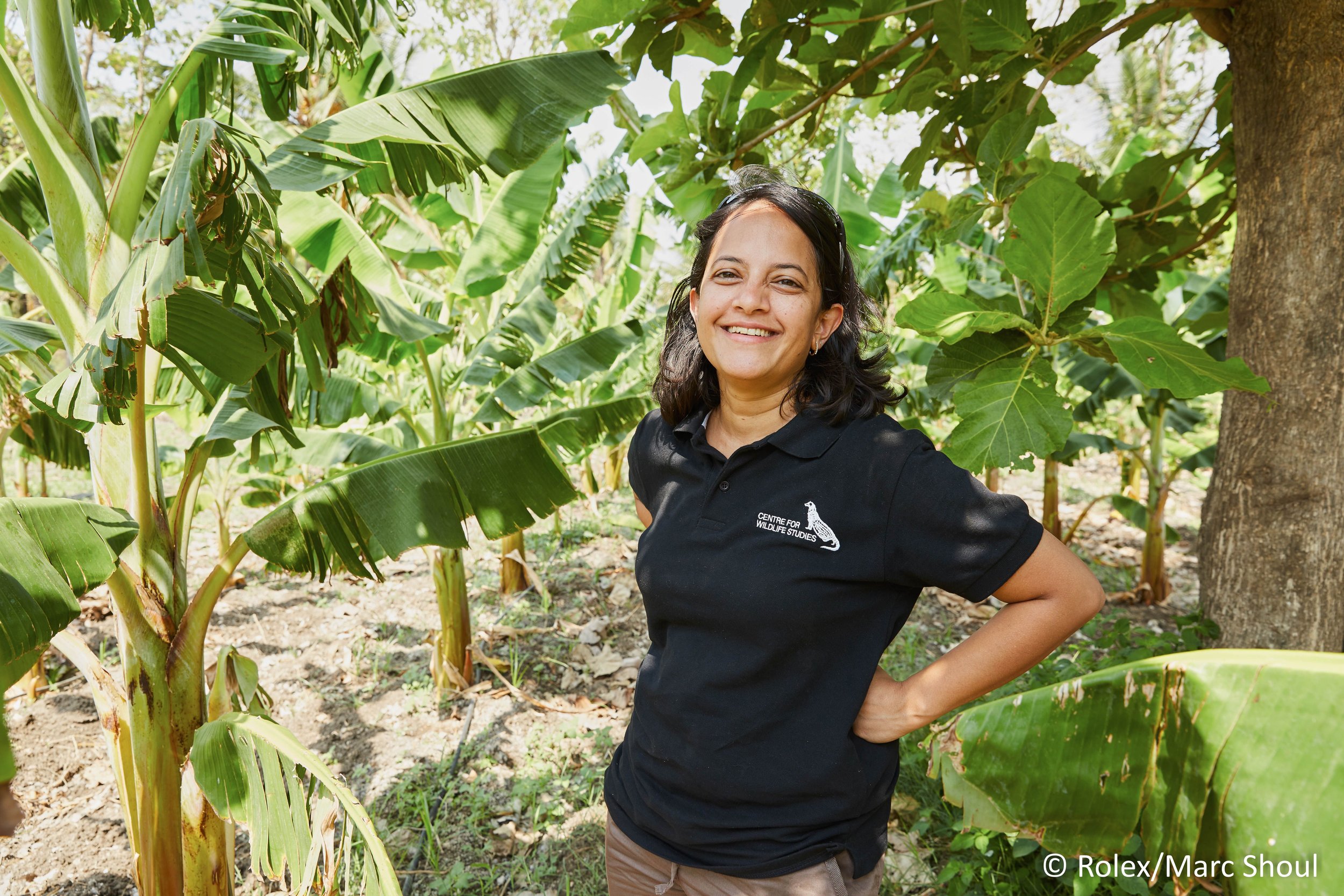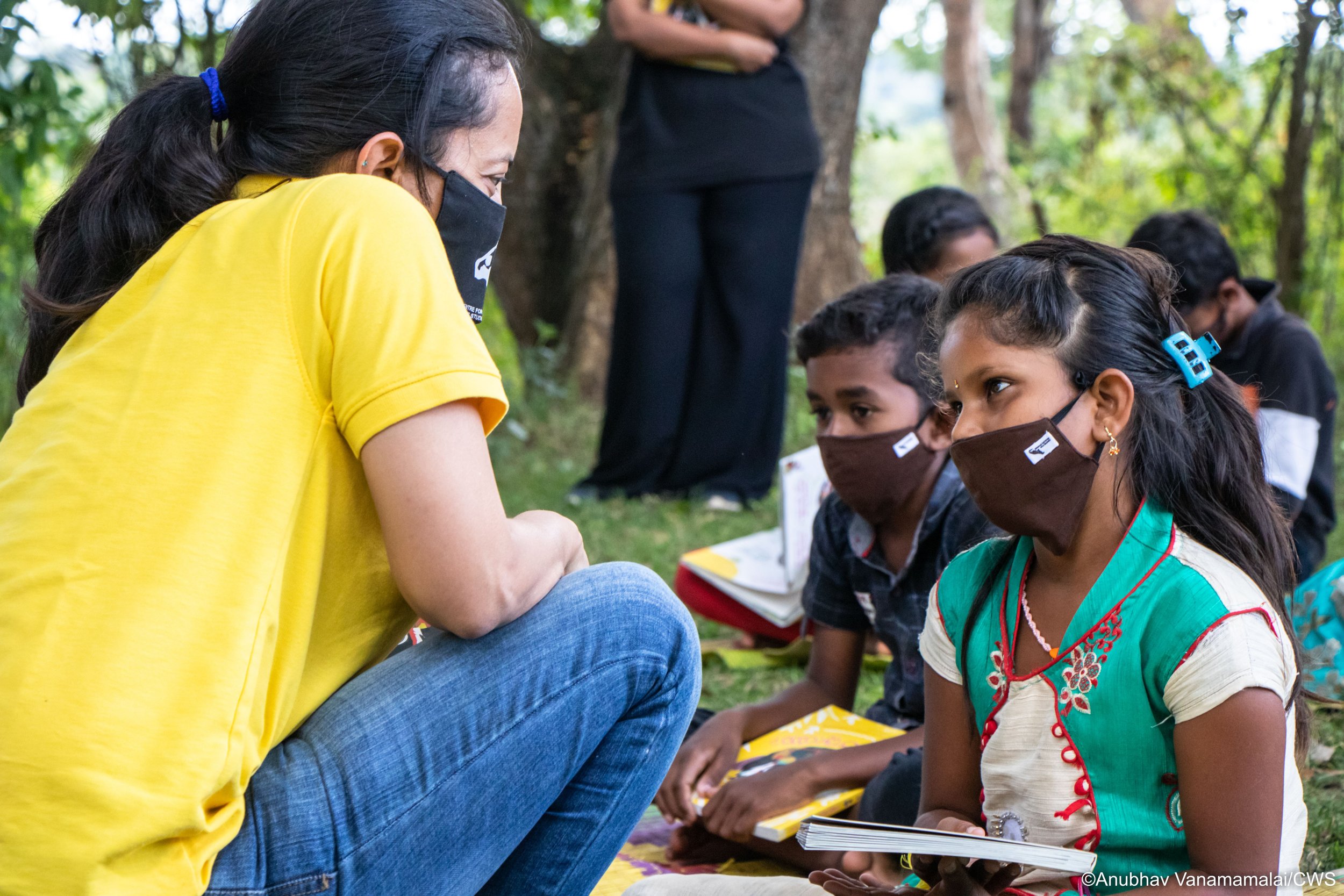Krithi Karanth: Aid, Education and Outreach in India During COVID
Dr. Krithi Karanth at Nagarahole, a UNESCO World Heritage site that supports an abundant variety of carnivores and herbivores. Photo Courtesy: Rolex/Marc Shoul
A WINGS Fellow since 2019, Dr. Krithi Karanth is the Executive Director and Chief Conservation Scientist at the Centre for Wildlife Studies (CWS) in Karnataka, India. Founded in 1984, CWS focuses on conserving India’s wildlife and wildlands through science, conservation, education and policy. A major focus area is to mitigate the negative impacts of human-wildlife interactions, especially conflict, in the many locations where the lines blur between the edges of the natural habitat of India’s wildlife and the boundaries of local communities. Because Dr. Karanth’s exceptional work includes both the preservation of species that call the parks of India home and conservation programs that improve the lives of people who live with wildlife, she was awarded the 2019 Women of Discovery Award for Conservation. As she flew back to India in 2019 with her WINGS pin, less than one year before the outbreak of COVID-19, Dr. Karanth was unaware that she and her organization were soon to face the imminent and immense transformation of the landscape of human-to-human and human-to-wildlife interactions. Over the next two years CWS would modify programs, redirect resources, and get creative to protect both humans and animals as the global COVID-19 pandemic had a devastating impact of over 500,000 deaths in India.
Luckily for the people within CWS’s current reach, the foundation of the program that would eventually address the sudden needs brought about by the pandemic was already underway, though it looked quite different from how it does today. With two major conservation initiatives, Wild Seve and Wild Shaale, already making marked progress, CWS began focusing on a third avenue to assist locals in alleviating the physical, emotional, and financial pain of inevitable wildlife interactions. After great success with the education of school children, “We realized that a lot of the adults in the communities, whether they be a community health worker, forest worker, or local, they call ‘panchayat,’ village leader, they themselves didn’t have basic information about wildlife,” Dr. Karanth explained in an interview with WINGS. “So we designed the program to do these day-long workshops with communities to build networks, to get the adults in the community to understand why does conflict happen, and how do you cope with conflict.” This program was named Wild Surakshe, meaning “safety” in Kannada, and was set to be launched one month before the outbreak of COVID-19.
Wild Shaale. Photo Courtesy: Anubhav Vanamamalai/CWS
Wild Shaale. Photo Courtesy: Anubhav Vanamamalai/CWS
In the early months of 2020, Dr. Karanth “realized that human-wildlife interactions are not just limited to these conflict situations. Disease transmission is also part of these interactions, and being research-focused… we dug deep and found that, other than COVID-19 in this part of India, …there were five other zoonotic diseases that transmit either between people and wildlife, or livestock and wildlife.” The first year of the 2020s brought with it the harsh reality of zoonotic diseases and highlighted the devastating impact a health crisis has on our ability to function economically and socially on both local and international levels. According to CWS, “Almost 75% of the emerging diseases in the 21st century are from wild animal reservoirs and have spread to people.” The first individuals affected by emerging zoonotic diseases are those that live on the boundaries of these reservoirs and parks, a reality that triggers both concern and hope. Given that those individuals act as the initial human carriers of the disease, Wild Surakshe plays the critical role of making sure that the ability to educate people on cautionary procedures overrides humanity’s innate desire to interact with others, especially when sick.
And so, in a time of necessary adaptation, Wild Surakshe took on a new form. When asked to discuss the expansion of the initiative, Dr. Karanth explains that it now includes, “talking about conflict, talking about disease, how to stay safe from conflict, what are the disease transmission pathways… again what are the behavioral changes people need to have so that you cut down your exposure. And then we also do a first aid session which helps both; where if you unfortunately do get injured, you know how to take care of somebody and make sure they get the right medical help.” When people consider dangerous or sometimes deadly interactions with wildlife in India, they may exclusively imagine large predators, but, Dr. Karanth explains, “one of the biggest causes of human deaths is that people die more from snakes than issues with tigers and leopards, and people don’t know what to do during a snakebite.”
Wild Seve. Photo Courtesy: Anubhav Vanamamalai/CWS
Wild Seve. Photo Courtesy: Anubhav Vanamamalai/CWS
With that in mind, first aid became a part of the day-long Wild Surakshe program. Most people in the United States do not have to worry about a venomous snake bite on an everyday basis, but those that do have access to quick information at their fingertips, which is not the case in some parts of rural India. When asked about what locals already knew about handling life-and-death first aid, Dr. Karanth responded, “There’s a lot of myths, you know, even on things like snake bites, or even positioning an injured person, as simple as that. Not touching them and doing the bare minimum to make sure they don’t choke. People are not aware of these things.” If one life is the measurement needed to declare this element of the initiative a success, then Wild Surakshe’s first-aid module has already reached its goal. In the Wild Surakshe introduction video on the CWS website, Project Coordinator Mamatha Prasad reported that one local woman’s feedback included that story of “somebody in the village [that] had gotten bitten by a Russell’s viper,” and went on to note that “It was wonderful to hear that, after attending our workshop, they could actually identify the snake… and get them timely treatment in the right way.”
Because the Wild Surakshe Conservation Initiative had to change course so quickly, and since the virus came in more than one wave, it was not always smooth sailing. “We started in September 2020,” Dr. Karanth explained as she walked WINGS through the timeline. “The first six months we spent re-designing the program, expanding to the disease side. Also, because of the lockdowns, we were not able to start earlier, so we started in September 2020 and worked to April 2021. Then there was a second lockdown with a three-month pause, then we started again. The project is still ongoing.” CWS met the constant and developing challenges with passion and dedication, resulting in the completion of 500 workshops in 34 parks since September 2020, almost half of the 69-wildlife-reserve goal, which covers parks in Goa, Karnataka, Maharashtra, Tamil Nadu, Kerala and Maharashtra. Continuing to conduct workshops across a large area of Southwest India will allow CWS to maintain an evolving map of the locations most likely to be “hot zones” for future disease transmission. Dr. Karanth hopes that “by next year we will have a complete disease and conflict profile for this entire landscape [Western Ghats’s biodiversity hotspot].”
Continuing the trend of surprising directions and outcomes of the Wild Surakshe Initiative, Dr. Karanth noted that “the unexpected thing that came from this work was that we built such a network [that] when the second wave of COVID hit India last April, we realized that… we are a wildlife conservation NGO working in really remote parts of India where primary health centers were very poorly equipped,” which was not as apparent initially “because the first wave was very much restricted to urban India.” However, Dr. Karanth continued, “the second wave, it went everywhere… and these primary health centers, doctors, and nurses were overwhelmed. They didn’t have the basic medical supplies. It’s not even oxygen, it’s PPE kits, thermal scanners, just stuff to monitor the disease and emerging outbreaks.” The combination of CWS’s new health initiative and expanding networks resulted in a new way to fight the COVID-19 pandemic, which would turn out to be a campaign with a mission, momentum, and magnitude unlike any in the Centre’s history.
From Wild Surakshe introduction video on the CWS website
As the Delta Variant spread across India, the members of CWS were in the thick of the action in incredibly remote parts of India. Although primary health centers do exist in rural India, “these are places where you need a four-wheel-drive vehicle to even go, and it takes days for people to walk to get to,” and, as was soon evident to everyone, even if one could reach a primary health center, they were under-equipped to help all the people they needed to. Going into detail on the thought process behind this new campaign, Dr. Karanth explained, “Initially we were hesitant to get into it because we are not a relief NGO, we are not a health NGO,” but with the bravery and spirit that define WINGS Fellows, “we realized that if we didn’t do it, nobody else would.”
From that courageous decision came the “Adopt-a-PHC” campaign: “a massive fundraiser… raising enough money to provide medical supplies, [and] anything these primary health centers needed.” CWS greatly surpassed their humble goal of 100 primary health care centers and, by December 2021, managed to reach 600 centers in 28 districts across three states. The decision to take on a health and relief program did not only prove to be the right choice on paper but was also celebrated on a personal level by Dr. Karanth and the CWS team. Dr. Karanth explained, “I am very glad we stepped in. It is kind of cool, because sometimes a lot of the research and projects we do in conservation are for the long term… It takes years before you see any results. This is an incredibly quick turnaround, and it kind of got all our staff super excited because you were in the thick of the action, when it was happening, and you were delivering stuff when it was needed, and I think there was an incredible adrenaline high and joy that came from being able to help instantly, which we had never seen before.”
Dr. Karanth conducting a field survey. Photo Courtesy: Kalyan Varma
In many ways, the COVID-19 pandemic affected people across the four corners of the earth in similar ways. It changed how people live, how they interact with each other, and how they interact with the world around them. The same issues, although on massively different scales, caused common effects, which often resulted in countries looking inward and neighbors helping neighbors. Dr. Krithi Karanth exemplifies what it means to be a leader, an innovator, and a WINGS Woman of Discovery. Not only did she refuse to let the pandemic interrupt her mission, she used the challenge to expand the focus of the initiatives in her purview as well as take the chance to help thousands across rural India in a new way.
Two years after the outbreak of COVID-19, Dr. Karanth shared that, “It is the evolution of the insights from Seve, the insights from Shaale, and now realizing that if you want to do conservation at a meaningful scale, to address human-wildlife interactions of all kinds, you need to build a baseline set of knowledge and information, build these networks of people who matter, whether they are frontline health workers, forest department workers, village leaders… so that when conflict happens or there are emerging new diseases that come in the future, we are better prepared to handle this stuff so it doesn’t reach the level it has today.”
The Centre for Wildlife Studies continues to mitigate the impact of human-wildlife interactions through education and outreach as it has for the last 38 years. However, thanks to the choices and innovative thinking of Dr. Karanth and the CWS team in response to the pandemic, the lessons brought into the field, to schools, to villages, and to people’s houses have grown to encompass what someone living in the post-COVID-19 world needs to know. As Dr. Karanth continues to use Wild Surakshe to educate those living on the boundaries of wildlife parks and reservoirs with little or no access to healthcare, the previously colossal task of identifying and halting the transmission of emerging zoonotic diseases in India will begin to shrink until it takes the shape of a highly promising frontline defense against another global pandemic.
From Wild Surakshe introduction video on the CWS website
Lessons From the Field
“I’ve had the privilege of mentoring several hundred people in India now, and I find that younger generations want instant gratification on everything very quickly. And when you are doing either scientific research or conservation, it takes years to collect data, it takes years to have an impact; nothing is going to happen in a few days or a few hours. And the ability to stay in the long game, which is decades if not a few years, is something I think a lot of younger people need to learn… I, after 24 years, don’t call myself an expert on anything, and you know you need to put your 10,000 hours in and some more…It’s going to take a long time to have any impact to have anything meaningful.” Krithi Karanth








